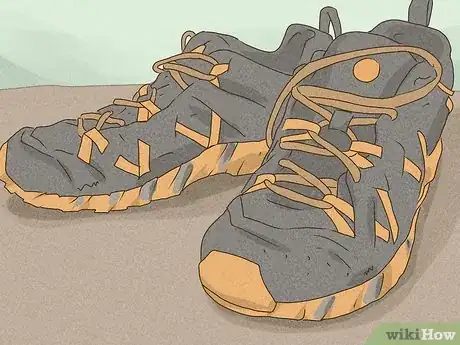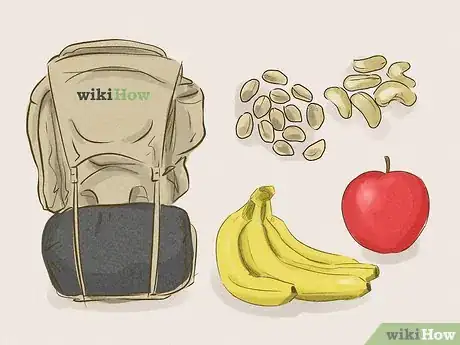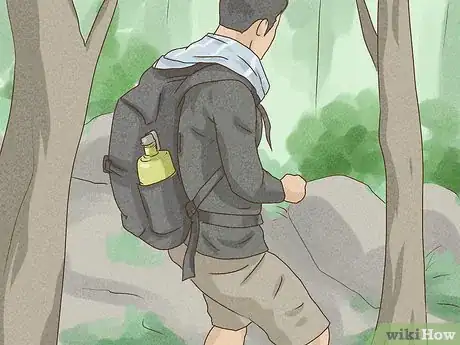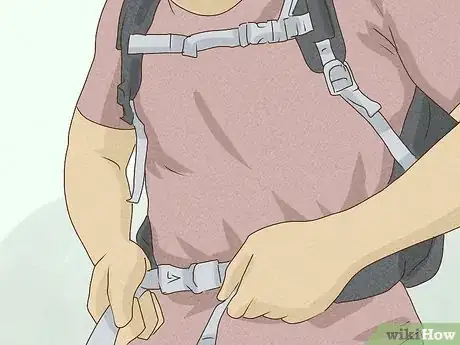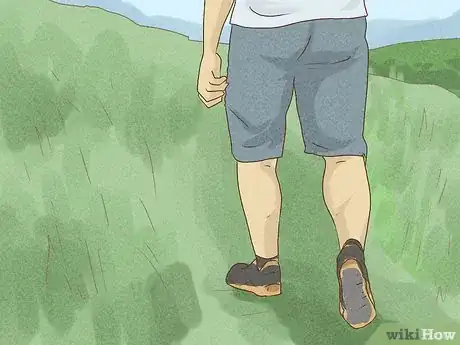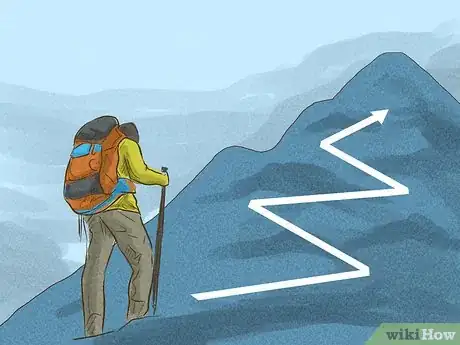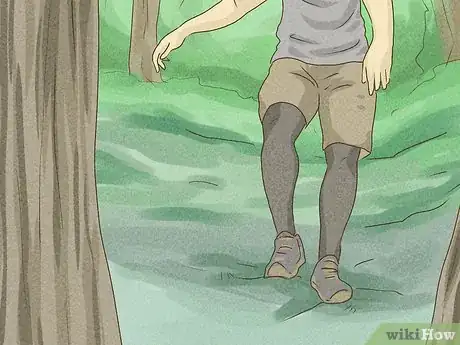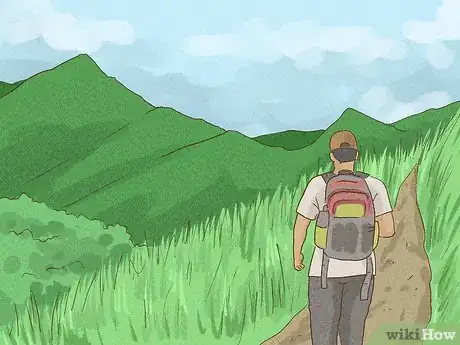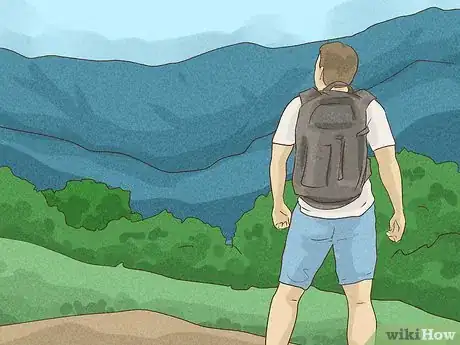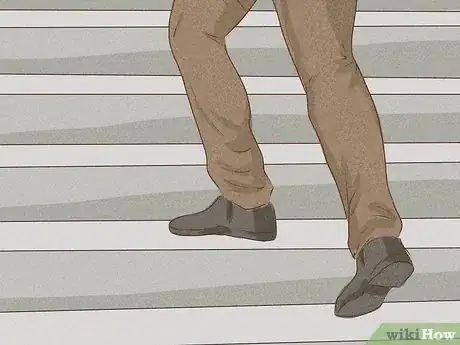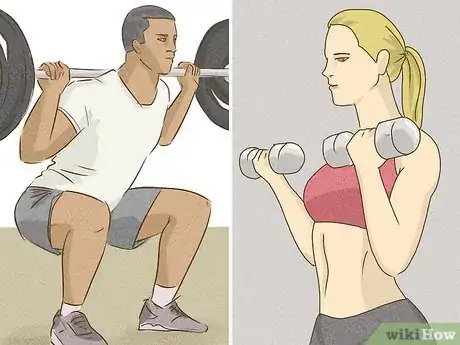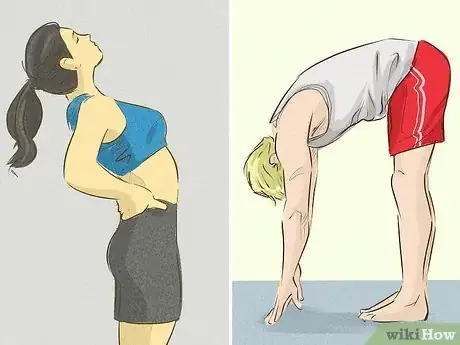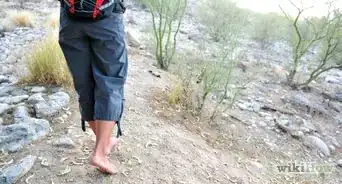This article was co-authored by Katie Prendergast. Katie Prendergast is a Certified Personal Trainer, Nutrition Coach, and the Owner of KPxFitness. With over seven years of coaching experience, she has expertise in helping skiers, snowboarders, and hikers build strength and endurance to enjoy more outdoor adventures. Katie earned her Personal Training Certification and Corrective Exercise Specialist Certification from The National Academy of Sports Medicine (NASM) and is a Pain-Free Performance Specialist (PPSC).
There are 8 references cited in this article, which can be found at the bottom of the page.
This article has been viewed 118,767 times.
Hiking is a great way to spend time and exercise in the great outdoors. But it can also be difficult and physically demanding, especially if you’re new to hiking.[1] Using good technique will make your hiking experience more fun and enjoyable, and with practice and the right gear, you can improve your technique to become a better hiker and take on more challenging trails.
Steps
Using the Right Gear
-
1Invest in a good pair of hiking boots. A sturdy, comfortable pair of hiking boots will help you hike longer and further. Wearing sneakers or boots that aren’t durable will make your hikes harder and may hurt your feet after a long day out on the trail. Choose a pair of well-fitting hiking boots to improve your overall hiking ability.[2]
- Look for high-quality hiking boots at outdoor supply stores, boot stores, or by ordering them online.
- Wear the socks you plan to wear on your hikes when you try the boots on so you choose a pair that isn’t too tight.
- A good pair of hiking boots often take some time to be broken in so they’re really comfortable.
-
2Pack small, nutrient-dense snacks in a lightweight backpack. Choose a well-fitting and sturdy backpack designed for outdoor use to store your snacks and gear. Pack small, lightweight snacks that are super-rich such as protein bars and trail mix so you’re able to satisfy your hunger cravings and keep your energy levels up while you’re out on the trail.
- Fresh fruit such as apples or bananas are tasty, lightweight, and will provide a healthy supply of energy.
- Nuts are always a nice, tasty snack to have that will keep you going and stave off major hunger cravings.
Advertisement -
3Store your water container in an easy-to-access location. Fill a canteen or a reusable water bottle with fresh water before you hit the trail so you’re able to stay hydrated. Keep it somewhere on your backpack or slung over your shoulder so you can access it easily without having to stop to take a sip.
- Hiking is a rigorous physical activity, which means you need to stay hydrated in order to keep going and replace any fluids you lose in your sweat.
- Store your water somewhere like on the side of your backpack so you can reach it while you’re on the go.
-
4Wear lightweight clothing made out of moisture-wicking material. Put on comfortable pants and a shirt made out of moisture-wicking material such as a polyester blend that allows your skin to breathe while also protecting against moisture and rain. If it’s cold where you’re hiking, add layers of clothing such as a nice, warm fleece jacket. Pack a raincoat in your backpack, just in case you get caught in a sudden downpour.[3]
- Pack a waterproof shell for your backpack so you can cover all of your gear to protect it as well.
- Look for clothing designed for hiking at outdoor supply stores or by ordering them online.
-
5Adjust your pack’s harness so it’s comfortable. Before you get out on the trail, put on your backpack and adjust the straps and components so it fits securely and comfortably on your back. As you’re hiking, the straps may loosen, or they may rub and become painful in certain areas. Make regular adjustments so the pack isn’t loose, but it feels comfortable so you’re able to keep going and enjoy your hike.[4]
- Put your pack on before you go hiking to make sure it isn’t too heavy. If it is, take out any unnecessary items to make it more manageable.
-
6Bring a smartphone with a compass and hiking apps. Download apps to your smartphone that map out the trail you’re hiking so you won’t get lost, even if you don’t have cell phone service or access to the internet. Your smartphone also has a compass app so you’re always able to find your direction. Charge your smartphone and pack it with your gear in case you need to use it.
- You can also download weather apps to keep track of any storms heading your way.
- Popular hiking apps include Topo Maps and Peak Finder.
-
7Use trekking poles to allow your arm muscles to help you hike. Trekking poles, also called hiking poles or hiking sticks, are 2 rods that you hold to help you hike. They allow you to incorporate your arms to make the trail more manageable. They also add extra stability. Choose a pair of trekking poles and adjust them so they’re a comfortable height for you to improve your ability to hike.
- Trekking poles are great to use on rocky or uphill terrain.
- You can find trekking poles at outdoor supply stores or by ordering them online.
Hiking Tip: If you don’t have or want to use trekking poles, a sturdy hiking stick can help you navigate the terrain and make you more stable out on the trail.
Developing Good Technique
-
1Hike a local hill 2-3 times a day to find your natural cadence. Experienced hikers set a good cadence or pace while they’re out hiking a trail so their steps are the same length and happen in the same amount of time. To find your own natural cadence, find a hill around your area that has a consistent slope. Walk up and down it a few times a day and focus on settling into a consistent rhythm with your steps. In time, you’ll build muscle memory that will help you out on the trail.[5]
- The hill can be paved and doesn’t need to be super steep.
- You’ll also build up your hiking muscles with regular trips up and down a hill.
-
2Set and maintain a steady pace to avoid getting fatigued. Whenever you’re out hiking, settle into your natural cadence so you’re able to make steady progress without breaking down or wearing yourself out. Keep the same pace for both uphill, downhill, and flat terrain. You’ll use less effort and will hike more efficiently by keeping a steady pace.[6]
Did you know? The reason cross country and marathon runners are able to run such long distances is because they establish a set pace and maintain it the entire time.
-
3Use a zigzagging pattern when you’re hiking uphill to make it easier. Breaking up the terrain on steep ascents or when you’re hiking uphill by zigzagging decreases the gradient and makes the climb easier. Zigzagging also uses different muscles with each step, which helps prevent your legs from getting tired out.[7]
- Try to keep the same pace, even as you’re hiking in a zigzagging pattern.
- Be careful when you’re hiking up rocky terrain so you don’t step on a loose stone and slip.
-
4Take smaller steps when you’re hiking downhill to keep your balance. Hiking downhill may feel easier, but it’s really important that focus on maintaining your footing and balancing so you don’t fall and potentially tumble down the trail. Take steps that are about half the length of your normal stride so you’re more stable and less likely to trip and fall.[8]
- Focus on your foot placement as well so you don’t slip.
- Smaller steps help keep your center of gravity over your feet so you’re not leaning forward.
-
5Choose the path of least resistance on cross country hikes. If you’re hiking without a trail or on a trail with lots of different types of terrain, take your time and look around whenever you approach an obstacle or a change in terrain. Look for the safest and easiest way to hike through the terrain and use that route to manage it more efficiently.[9]
- Avoid burning yourself out by choosing the most difficult route possible, especially on long hikes.
- Cross country or terrain without trails are often more remote and are less likely to have people on them, so it’s important that you’re as safe as possible when you’re hiking them.
-
6Take short, consistent breaks to stay fresh on the trail. Stopping to take a short, 5-minute rest every 2-3 hours will actually keep you moving faster on the trail because you’ll feel refreshed and ready to keep going. Find a nice place to take a short break, take off your backpack, and stretch out your muscles before you get back on the trail.[10]
- Adjust your backpack when you put it back on so it’s more comfortable.
- Take a sip of water and have a small snack to get your energy levels back up.
Training to Improve Strength and Stamina
-
1Take shorter hikes to build up your hiking endurance. The best way to improve your hiking ability is to get out there and hike![11] Start with shorter, less difficult trails to get your body used to hiking. As your ability improves, keep challenging yourself with more and more difficult trails. Over time, your technique, endurance, and ability will increase.[12]
- Look online for hiking trails in your area that you can check out.
- Many parks and hiking trails will indicate the difficulty of the trail. Start with the easier trails first and work your way up to the more difficult ones.
-
2Climb stairs to improve your hiking stamina. Hiking is a strenuous activity that requires lots of endurance to keep going. Climbing stairs will challenge your muscles and increase your cardiovascular conditioning while roughly simulating the movements of hiking. Visit a local park or stadium with stairs you can use to build up your stamina.[13]
- Some gyms have stair climber machines that you can use as well.[14]
- Try to take the stairs instead of an elevator or escalator any chance you get!
-
3Use cardiovascular exercises to improve your physical conditioning. Building up your cardio will improve your ability to go on longer, more demanding hikes.[15] You won’t break down or get too fatigued while you’re out on a trail if your physical conditioning is on point. Try to do some cardiovascular exercise at least 2-3 times a week to stay in shape and increase your conditioning.[16] [17]
-
4Do strength training to build stronger muscles. Hiking also demands a lot from your muscles, so adding some weight lifting to your fitness regimen will help build up your muscles so they’re strong enough to handle anything the trail throws at you. Add at least 1-2 weight lifting workouts a week to increase your strength and improve your ability to hike tougher, more demanding trails.[20]
- If you’re new to weight lifting, work with a trainer or an experienced partner to make sure you’re using good form and won’t injure yourself.
- Use weights that are appropriate for you. Trying to lift weights that are too heavy can cause you to injure yourself, which could keep you from hiking!
-
5Stretch regularly to improve flexibility and lung capacity. Stretching your muscles at least once a day will increase your flexibility and mobility, which will allow you to handle the ever-changing demands of a hike. Stretching also helps to expand the muscles of your rib cage and diaphragm, which will help develop a greater lung capacity for hiking.[21]
- Stretching also helps release tightness in your muscles after a long hike or a challenging workout.
Tip: Do yoga to stretch your muscles, improve your balance, and increase your breathing ability. Look online for videos you can follow or for classes being offered in your area for guided instruction.
Expert Q&A
-
QuestionHow do you strength train for hiking?
 Katie PrendergastKatie Prendergast is a Certified Personal Trainer, Nutrition Coach, and the Owner of KPxFitness. With over seven years of coaching experience, she has expertise in helping skiers, snowboarders, and hikers build strength and endurance to enjoy more outdoor adventures. Katie earned her Personal Training Certification and Corrective Exercise Specialist Certification from The National Academy of Sports Medicine (NASM) and is a Pain-Free Performance Specialist (PPSC).
Katie PrendergastKatie Prendergast is a Certified Personal Trainer, Nutrition Coach, and the Owner of KPxFitness. With over seven years of coaching experience, she has expertise in helping skiers, snowboarders, and hikers build strength and endurance to enjoy more outdoor adventures. Katie earned her Personal Training Certification and Corrective Exercise Specialist Certification from The National Academy of Sports Medicine (NASM) and is a Pain-Free Performance Specialist (PPSC).
Certified Personal Trainer & Nutrition Coach Squats, box step-ups, step-downs, split squats, lunges, glute bridges, and Romanian deadlifts are the best strength exercises for beginner hikers. Choose 1-2 "quad dominant" exercises like squads and lunges and 1-2 "hip dominant" exercises like bridges and deadlifts and do 3-4 sets of each exercise for 8-12 repetitions per set. Two strength workouts per week should be enough!
Squats, box step-ups, step-downs, split squats, lunges, glute bridges, and Romanian deadlifts are the best strength exercises for beginner hikers. Choose 1-2 "quad dominant" exercises like squads and lunges and 1-2 "hip dominant" exercises like bridges and deadlifts and do 3-4 sets of each exercise for 8-12 repetitions per set. Two strength workouts per week should be enough! -
QuestionHow can I increase my stamina for hiking?
 Katie PrendergastKatie Prendergast is a Certified Personal Trainer, Nutrition Coach, and the Owner of KPxFitness. With over seven years of coaching experience, she has expertise in helping skiers, snowboarders, and hikers build strength and endurance to enjoy more outdoor adventures. Katie earned her Personal Training Certification and Corrective Exercise Specialist Certification from The National Academy of Sports Medicine (NASM) and is a Pain-Free Performance Specialist (PPSC).
Katie PrendergastKatie Prendergast is a Certified Personal Trainer, Nutrition Coach, and the Owner of KPxFitness. With over seven years of coaching experience, she has expertise in helping skiers, snowboarders, and hikers build strength and endurance to enjoy more outdoor adventures. Katie earned her Personal Training Certification and Corrective Exercise Specialist Certification from The National Academy of Sports Medicine (NASM) and is a Pain-Free Performance Specialist (PPSC).
Certified Personal Trainer & Nutrition Coach Long aerobic exercises and sprint interval workouts are great options! For a long aerobic workout, use a heart rate monitor to stay in heart rate zone 2 (60-70% of your heart rate max). For an interval workout, do 6-8 hard intervals lasting 45-90 seconds, followed by 2-3 times the amount of rest.
Long aerobic exercises and sprint interval workouts are great options! For a long aerobic workout, use a heart rate monitor to stay in heart rate zone 2 (60-70% of your heart rate max). For an interval workout, do 6-8 hard intervals lasting 45-90 seconds, followed by 2-3 times the amount of rest. -
QuestionHow do I improve my breathing so I don't tire out so easily?
 Community AnswerTraining and cadence are key, just as the author says. Inhale as you step forward with one foot, then exhale as you step with the other. Exercises to strengthen the diaphragm and other chest muscles may also help. Sometimes on a steep ascent your mind's perception can affect your breathing, making you labor harder than you need to. One way to combat this is to pick a head-high visual target -- a trail blaze, for example -- and keep focused on the target as you climb.
Community AnswerTraining and cadence are key, just as the author says. Inhale as you step forward with one foot, then exhale as you step with the other. Exercises to strengthen the diaphragm and other chest muscles may also help. Sometimes on a steep ascent your mind's perception can affect your breathing, making you labor harder than you need to. One way to combat this is to pick a head-high visual target -- a trail blaze, for example -- and keep focused on the target as you climb.
Warnings
- Avoid lifting weights that are too heavy or performing exercises you’re unfamiliar with so you don’t hurt yourself.⧼thumbs_response⧽
References
- ↑ Katie Prendergast. Certified Personal Trainer & Nutrition Coach. Expert Interview. 21 February 2022.
- ↑ https://www.savisas.com/blog/improve-hiking-techniques-south-african-hiking-trails/
- ↑ https://www.wta.org/go-outside/new-to-hiking/hiking-101-1/hiking-101-part-2-selecting-clothing-and-gear
- ↑ https://www.savisas.com/blog/improve-hiking-techniques-south-african-hiking-trails/
- ↑ https://www.savisas.com/blog/improve-hiking-techniques-south-african-hiking-trails/
- ↑ https://trailandsummit.com/how-can-i-get-faster-at-uphill-hiking/
- ↑ https://www.thehikinglife.com/skills/hiking-techniques/
- ↑ https://www.thehikinglife.com/skills/hiking-techniques/
- ↑ https://www.thehikinglife.com/skills/hiking-techniques/
- ↑ https://trailandsummit.com/how-can-i-get-faster-at-uphill-hiking/
- ↑ Katie Prendergast. Certified Personal Trainer & Nutrition Coach. Expert Interview. 21 February 2022.
- ↑ https://ag.purdue.edu/stories/conquering-the-trail-trail-tips/
- ↑ https://trailandsummit.com/how-can-i-get-faster-at-uphill-hiking/
- ↑ Katie Prendergast. Certified Personal Trainer & Nutrition Coach. Expert Interview. 21 February 2022.
- ↑ Katie Prendergast. Certified Personal Trainer & Nutrition Coach. Expert Interview. 21 February 2022.
- ↑ https://bearfoottheory.com/improve-hiking-lung-capacity/
- ↑ Katie Prendergast. Certified Personal Trainer & Nutrition Coach. Expert Interview. 21 February 2022.
- ↑ Katie Prendergast. Certified Personal Trainer & Nutrition Coach. Expert Interview. 21 February 2022.
- ↑ Katie Prendergast. Certified Personal Trainer & Nutrition Coach. Expert Interview. 21 February 2022.
- ↑ https://bearfoottheory.com/improve-hiking-lung-capacity/
- ↑ https://www.backpacker.com/skills/how-to-walk
- ↑ Katie Prendergast. Certified Personal Trainer & Nutrition Coach. Expert Interview. 21 February 2022.
- ↑ Katie Prendergast. Certified Personal Trainer & Nutrition Coach. Expert Interview. 21 February 2022.

